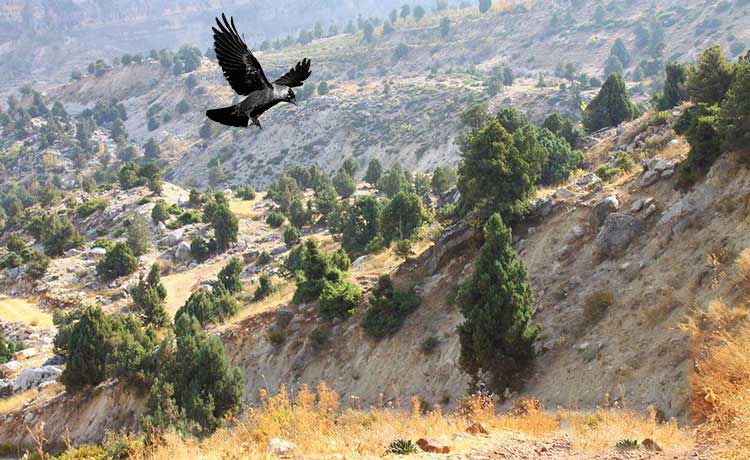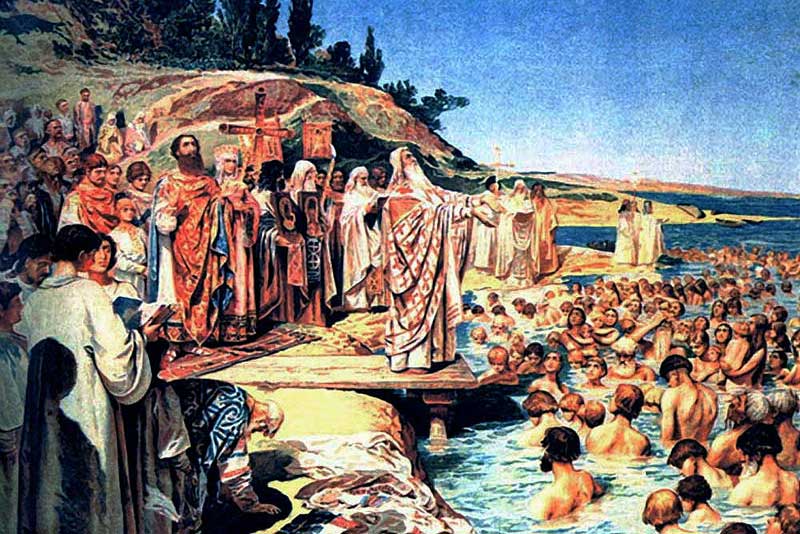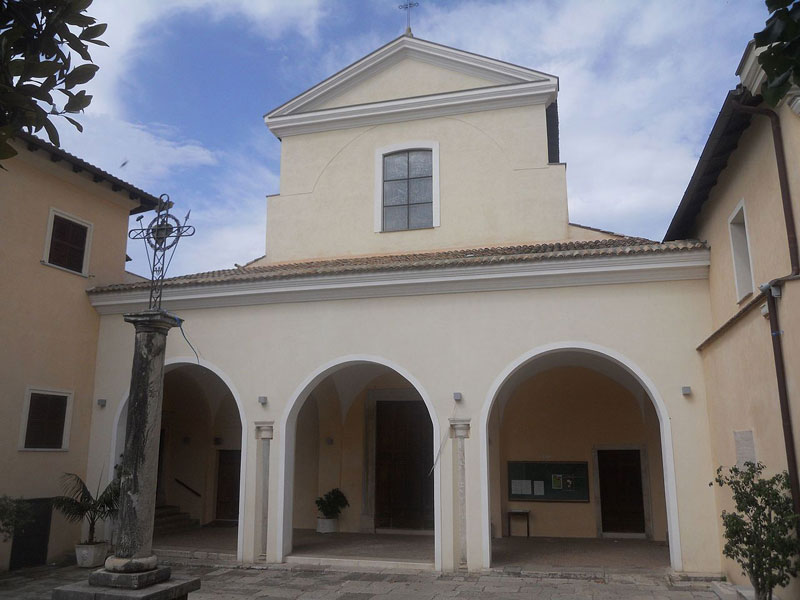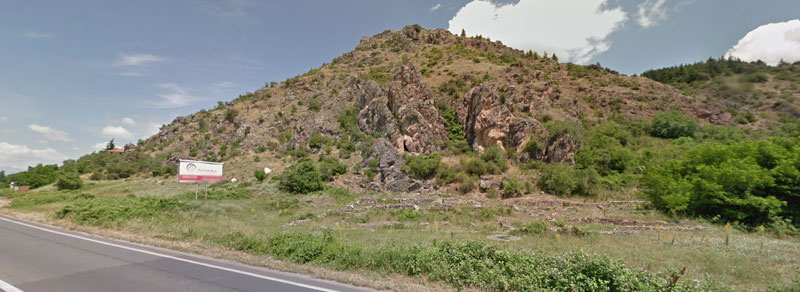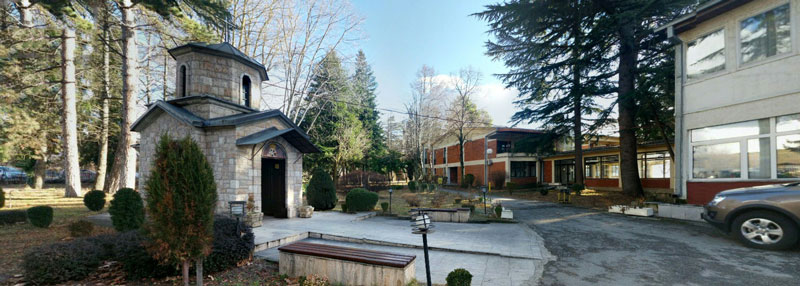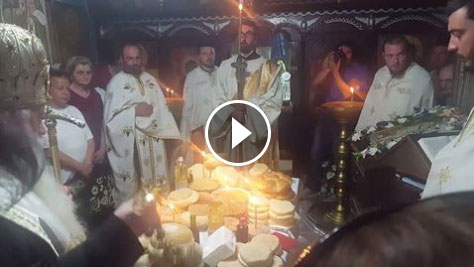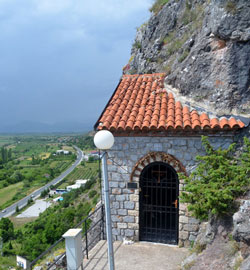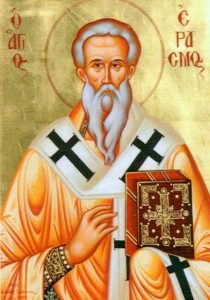
The hagiography of St. Erasmus does not provide information about his parents, why he chose the path of suffering, and what was crucial for a young man to become a bishop, against his will.
Saint Erasmus was young, handsome, of an angelic type, with a rich spirit, “his eyes were like sunshine,” with a calm and mild voice, but sharp against his torturers, to their malice he defied without any doubt with the support of Jesus Christ.
In the city of Antioch, Diocletian conducted terrible persecution of Christians. Fearing that he can not withstand the suffering, and fail his God Jesus Christ, St. Erasmus retreated 7 years in the desert. He did many miracles on Mount Lebanon. He received food from heaven by a falcon (according to some authors: raven).
Raven of Lebanon mountain
The wild beasts came to his cave to worship him, he spoke with the angels, and from heaven he heard a voice:
“Erasmus, get out of here and go to your homeland”.
Coming from Mount Lebanon, on the way to Antioch, on his way he cured many helpless people and attracted quite a lot people through the sacred baptism.
Realizing the presence of St. Erasmus in the city, Diocletian ordered to bring St. Erasmus before him. In front of the Senate of Antioch, Diocletian exerted great pressure on St. Erasmus to give up of Jesus Christ, to worship idols, by promising earthly blessings and riches. However the saint did not changed his mind even after the great beatings. He called the tyrant: a ravenous wolf, a deceiver of the souls, the son of the devil.
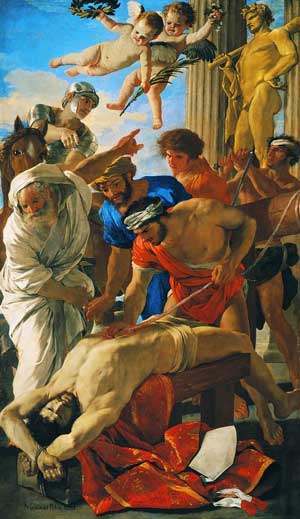
The torture of St. Erasmus – Source: Wikipedia, a photo of Nicolas Poussin – 1628
It didn’t help the tearing of the body of St. Erasmus with iron pliers, so he was thrown with a melted mass of tar, asphalt and wax, but the angel of the Lord was cooling the martyr. Saint Erasmus was saying:
“Tsar, where are your punishments … “
Seeing the righteousness of the martyr, the Antiochite Senate asked Diocletian:
“Let the righteous man and the bishop of the city go, because through him the Christian God acts.”
An earthquake suddenly arose. One third of the people died. And that accident Diocletian has attributed to St. Erasmus saying:
“The one you see is slandering (our gods) and therefore this disorder is done”
Saint Erasmus was put in prison with chains on his neck and legs, and the servants were ordered to keep him under strict conditions. However, through prayer to Jesus Christ and with his help, St. Erasmus, as a pigeon of Christ, was taken from an angel who took him to the place of Lurchedon. According to the second, short hagiography, it was Lychnid/Ohrid, which was under the rule of Maximilian.
In the Ohrid coast, Erasmus worked for ten years (293-303). He spread Christianity, making numerous miracles, giving sight to blind people, healing hopeless cases … He was gifted by God with supreme grace, even to resurrect the dead.
There is one case where Anastas’ son died. Before being put down in the tomb, St. Erasmus told the father Anastas that if he believed in the Lord Jesus Christ he could resurrect his son. And not only him, but the huge present crowd and others who knew about the resurrection of the dead man, were massively baptized (according to the long hagiography – 40,000 people).
For the missionary activity of St. Erasmus, he was slandered by pagan judge Probus to the Emperor Maximian, ruler of the Western Roman Empire. He ordered the saint to be brought to him immediately.
And from Maximian as well, he was persuaded to give up the Lord Jesus Christ and acknowledge the pagan gods, otherwise he will end up crucified in Jerusalem, saying to him:
“Have mercy on your soul, praise, and offer a sacrifice to my gods.”
To the question:
“What gods do you command me to worship?”,
Saint Erasmus, accompanied by many people, was taken to the temple of Heracles, and according to the second hagiography, to the temple Zeus. The saint was found in front of the enormous statue of Maximian’s pagan saint. As soon as the St. Erasmus looked at the statue, it fell, it became dust and ash, and a dragon came out from within. Frightened Maximian fled, and St. Erasmus tamed the dragon.
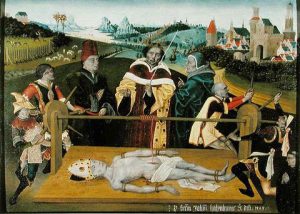
The torture of St. Erasmus – Source Wikipedia – Dutch painter 1474 year..
Seeing this God’s power of St. Erasmus, 20,000 people were baptized. The king ordered St. Erasmus to be arrested, bound with 192 kg of iron chains and to apply all possible tortures.
According to the order of the emperor, a copper outfit was made and was blazed on St. Erasmus. But, by the grace of God, it cooled off like snow and nothing was damaged on Erasmus’s body.
The king ordered St. Erasmus to be immersed in a 38-liter barrel with boiling lead, resin, tar and oil, but the barrel was scattered.
The scattered king begged:
“God’s man, I am burning, pray for me”.
And the Saint saved him. Seeing this, many of the people believed in Christ. Then the angel Michael came and said to him:
“Erasmus, stand up! Look! I am the angel Michael sent to you to lead you to Campania, in the city of Formia, to preach to the people.”
Worn by the angel of the Lord, St. Erasmus came to Durres. There he was waiting for a boat (in some reviews – a rowing boat) and through the Adriatic Sea he came to Formia, near Naples.
According to the longer hagiography, in Formia he received food from an angel. He lived for 7 days there and heard a voice:
“Erasmus, come and rest in the holy city … Through you I am glorified, both in heaven and on earth.”
Before accepting St. Erasmus the precious crown, he asked:
“Lord Jesus Christ, son of God, one born, order me to rest in the place which is the place of your praise. Let me, if anyone asks me in Your name, to receive his reward from You. And I, Erasmus, will not depart from this place neither on Saturday nor Sunday. “
A voice was heard from heaven:
“Bravely, my beloved Erasmus for all that one will ask, I will give, even more than that he will receive”
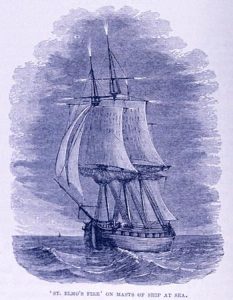
The fire of St. Erasmus – guardian of the ships, carving 1886
In the smaller hagiography, the demands of St. Erasmus from the Lord Jesus Christ and his promises are as follows:
“Help those who are in danger, at sea, on rivers, and in any other place to be saved from danger. For those who honor my memory, give them forgiveness of their sins and everlasting life, and be a helper and a good-hearted. “
A voice from heaven said to him:
“So it will be as I will promise, and more will be fulfilled to him who worships Me, Erasmus.”
Satisfied St. Erasmus entered “in the joy of his Lord” on June 2 (old style) or June 15 (new style) 303 year. St. Erasmus is present in his temples, at every place when someone is approaching him with the cross sign, that’s why St. Erasmus still does his miracles today.
St. Erasmus was buried on the west side of the city of Formia, where the cathedral was later erected “Saint Erasmus Bishop and Martyr”
The Cathedral of St. Erasmus, Formia, Lazio, Italy
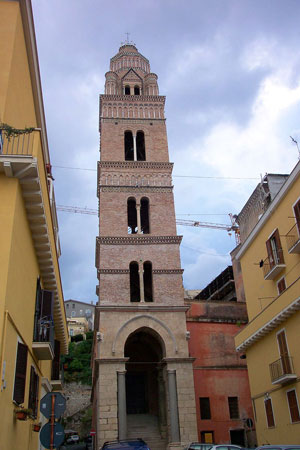
Kambanarium of St. Erasmus Cathedral in Gaeta
In the destruction of Formia by the Saracens in 846, the relics of St. Erasmus was transferred to Gaeta in 917, located in the church of St. Mary, from where they were returned to Formia after 30 years.
Because of this strolling of the holy relics, among these two cities (Formia and Gaeta) there are several temples dedicated to St. Erasmus, in which there are his holy relics.
Jurzi Maria Veseli (writer “Lihnid”, 6, 1988) writes:
In Formia on June 2, there were entrusted to him all “sea sacrifices” during a “procession” from boats and boats. From the port of Formia to the harbor in Gaeta, was threw into the sea a laurel wreath with an exciting prayer for all those swallowed by the waves, which were to be met with only one anonymous burial entrusted to Erasmus.
Starting from the short hagiography, all literature of Slavic origin, is bringing Saint Erasmus from Formia to Hermelia/Ohrid, where he retired to a cave where he ascended until death.
Did St. Erasmus returned to the place where he and his baptized experienced unseen evil from Emperor Maximian and whether he could return from exhaustion does not matter. The most important thing is that St. Erasmus is still in Ohrid with his presence, on which a living witness is the monastery “St. Erasmus” and in it the cave church “St. Erasmus”.
The cult of St. Erasmus came to the fore during his earthly life, and soon afterwards he was celebrated in the temples built in his honor. Besides the two churches in the monastery “St. Erasmus” and the ones we said in Italy, there are two more in Ohrid.
On the locality “St. Erasmus” in 1974-1980 a monumental three-necked early-Christian basilica was discovered with: narthex, atrium, auxiliary annexes and baptistery, with a pool, with luxurious mosaics in the dimensions 54×25 m, dedicated to St. Erasmus. It is assumed that it was erected in a previously sacred place. Too bad that basilica is not conserved and scientifically presented.
On March 11, 2000, the cornerstone of the hospital church / chapel “St. Erasmus” was laid in the yard of the Special Hospital for Orthopedics and Traumatology (Kosnozglobna). The act of sanctification on the foundation stone was performed by the competent Metropolitan Timothy, who sanctified the church on March 16, 2002. This hospital church, a chapel, was monographically painted by Prof. Dr. Mile D. Mickunovic under the title “Hospital church of St. Erasmus” (Ohrid, 2002, 1-80, A4 format)
Wherever St. Erasmus is respected, it is also present his character. In addition to the cave church, in the 13th century, in Ohrid, the character of St. Erasmus is represented in the church “St. John” – Kaneo, in his temples dedicated to him or to other saints. It can be meet in the Prototone of Mount Athos (1526).
Because of its popularity, St. Erasmus is also present in some compositions of the seven-chronicles, most often, Gorazd (for example, in “The Virgin” – Kamensko in fresco and in an icon, in “Prechista”, Kichevo, etc.)
The cult of St. Erasmus is present on quite a giant space, even on the shores of Portugal. To that particularly contributed his adventurous journey to Durres, to Formia along the Adriatic Sea. Therefore, Erasmus became “the universal and immediate patron of all sailors”.

Men carry a statue from St. Erasmus to St. Erasmus church in the name of passing the ships in the sea, June 2, 2016, the island of Corsica, celebrating the St. Erasmus holiday
Other cities of Italy and Germany also noted with special pride that they owned his relics. In Belgium, Germany and elsewhere, you can find images of the saint with a broken womb (the images from the above where the sorrowing of the saint is shown), because of which the people called him a protector of the abdominal and birth pains.
In many places, he is also respected as a protector of animal diseases and epidemics, and in coastal areas of Italy, Spain, France and Portugal he is respected as the patron of sailors.
The name of St. Erasmus in the Ohrid – Struga region is Razmo. Like: Razmo, Razme, Razmenka, his name is widely penetrated to wider areas of Macedonia (mainly in Skopje and in the western part), where it is also found in the form of Razman. The reason for his penetration into onomastics is the meaning of his name: dear, beloved, friend.
One commemorative song (icos) for St. Erasmus says:
“As the sun has made the universe come alive with the rays of light, so the God’s follower enlightened the environment with countless miracles”
The countless illumination of the surroundings with his miracles, St. Erasmus was doing with Jesus Christ in him. Everything that St. Erasmus did it was with a cross sign and with a plea for help from the almighty God, whom he was “beloved.”
The numerous miracles of St. Erasmus we have already stated, but here we list them completely for their sublimation:
- When St. Erasmus is in the wilderness, on Mount Lebanon, from the sky he was given food from a falcon (raven); the angels spoke with him, the beasts came to his cave, worshiped him, and became an expander on his feet (on them to walk);
- The voice from heaven tells him to leave the desert and go to his homeland. Leaving Lebanon, as soon as he put his hands on the men with unclean spirit, they immediately recovered.
- From the beating by orders of Diocletian and Maximian there are no traces on his body, even when he was thrown with a hot mixture of tar, asphalt, wax and oil. There are no consequences from the heated copper outfit. By doing so he turned the ungodly into the knowledge of God.
- He is released from prison in a way, fetters melt as wax and freed from them when an angel passes him to the port of Durres, and from there he sails to Italy or he is carried by an angel.
- With his piercing eyes, the sculpture of Heracles/Zeus turns it into dust, and from it the raging dragon was calmed down.
- The dead son of Anastas comes to life; the blind returned their eyesight, the sick people healed.
- All the actions of the relentless antichrists Diocletian and Maximian was ridiculed by him. He is proud before the torturer, calling him a predatory wolf, a deceiver of souls, a meatloat, a devil’s son, etc.
With his spiritual power, St. Erasmus is present to this day when a believer addresses him with a cross sign honestly in his temple, or in his everyday life wherever he is. That’s why, on his holiday from the evening (June 14th to June 15th), the river of people come the monastery “St. Erasmus”, but on every day through the year there are visitors there.
Every visitor comes in gratitude for something to the saint, to pray for he saint to help him for health and happiness for himself and for the family or with some special desire. All who came to him honestly, with faith, has not received anything bad from it. On the contrary, they get very lucky, they saw some good, they were mentally released. Saint Erasmus rewards, but also punishes.
Attachment to the miraculous power of Sts. Erasmus so far, surely in the future are the many enclosed records of his miracles experienced in our area connected with the monastery “St. Erasmus”, most noticed with the help of Mrs. Vesa Grazhdani, Mr. Klime Nishcheski and Prof. Dr. Stojan Risteski, for which we thank them.
Most of the information on this web site was obtained thanks to Dr. Stojan Risteski and his book “The Miracles of St. Erasmus” that you can buy from the monastery at any time.
We also thank other informers as well as future informers who will contact us with new content. You can use the site’s contact form at any time to share any of your experiences and with your permission, we will be pleased to announce them here.
In the statements, it’s up to him/her to believe it or not, but the facts stated in them are facts, and the facts remain facts. Indeed, Russian writer Maxim Gorky says that there is only one thing in which a man believes, but when something strikes in the most sensitive, in the most painful place, everyone will believe what he did not believe, and indeed he would have demanded forgiveness and mercy from him.
The pilgrims with every visit to the monastery “St. Erazmo” are mentally refreshed, and visitors of the Ohrid coast will return to their places spiritually richer. Who was in Ohrid, and did not visit the monastery “St. Erasmus”, he missed a lot.
